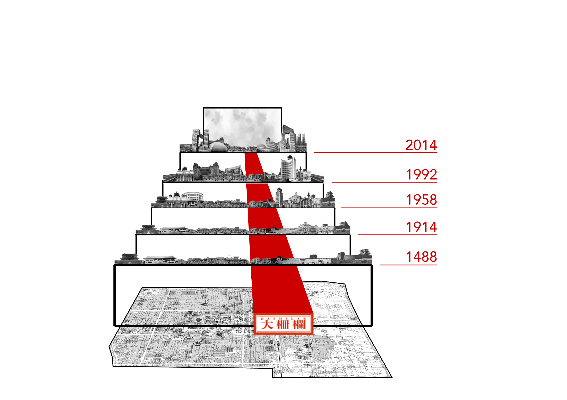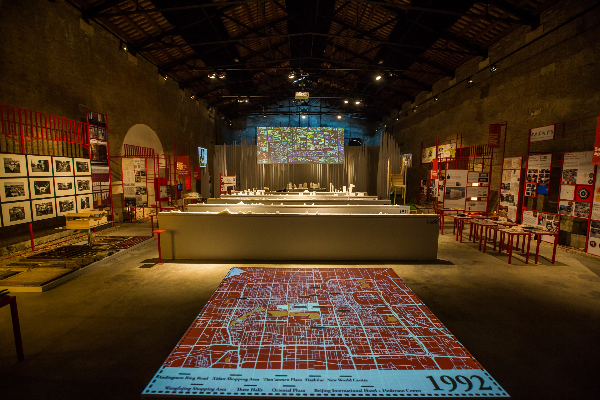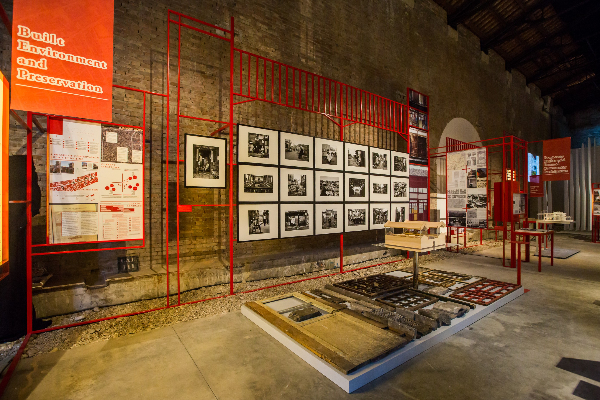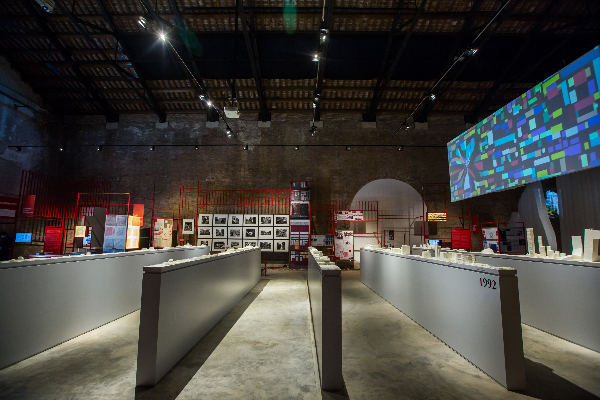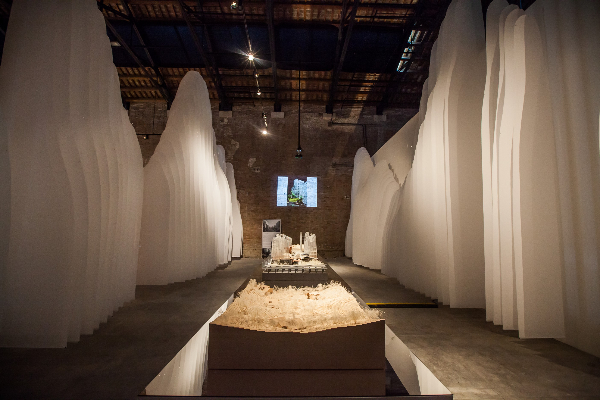Beijing Design Week presented “Across Chinese Cities – Beijing” — the frist of three projects in the Across Chinese Cities reserach program – as an official Collateral Event of the 14th International Architecture Exhibition – la Biennale di Venezia.
An investigation into the Chinese capital’s spatial transformations and its historical district Dashilar, the exhibition expounds upon the complex architectural and social transformation of the city, looking at contemporary challenges between globalisation and localism, the processes of continuous adaptation and resilience found therein which remain paradigmatic for many contemporary cities like Beijing.
“Across Chinese Cities – Beijing” responds to the thesis set forth by Rem Koolhaas with “Absorbing Modernity” by looking at Beijing’s mutations in relation to Dashilar’s in two juxtaposed sections: “Across City Sections” and “Across Dashilar”. Dashilar, a city within the city, an historical and peculiar area situated southwest of Tian’anmen Square, becomes a prism to observe the whole city and the contemporary urban condition. Dashilar’s interwoven fabric of traditional courtyards and alleys (hutongs), the vibrant and dense urban and social ecosystem of crafts, specialized knowledge, infrastructures and historic buildings are taken here as experimental platforms for innovative pilot projects. Characterised by capillarity and porosity, its built forms and social condition offer themselves to a productive retooling and questioning of existing spatial devices: an engine for urban regeneration and reinvention.
“Across City Sections” consists of an installation composed by a map of the city and by a linear timeline of five city sections. Each scaled 1:500 along Beijing’s North-South axis they are temporally posited along five crucial moments: 1488: Foundation of Dashilar, 1914: Construction of experimental Xiang Chang District,1958: Inauguration of Tian’anmen Square,1992: Opening of Henderson Centre, first Shopping Mall, 2014: Beijing today, the global city. From within these spatial and temporal sections, the invariant core of the Forbidden City and the grand transformations of the urban fabric are set in contrast with the small-scale changes in Dashilar, attesting to its adaptive capacity across different historical thresholds.
Juxtaposed to the linear enunciation of “Across City Sections”, “Across Dashilar” draws a circular and explorative path across the socio-cultural dynamics, the economic and political factors which, since its foundation, have shaped Dashilar as a space of productive marginality. Originally founded outside the imperial city’s walls as an ‘outer city’ or external settlement, Dashilar evolved into a spatial dimension of autonomous alterity, where social and behavioural hierarchies were subverted. The historical mesh enveloping Dashilar unfolds into four historical moments (the Mongol Dynasty in the XV century, the Ming and Qing period, the end of the empire and the first Republican period, the foundation of the People’s Republic in 1949 until the economic reforms of the 1990s, the pre Olympic period and the XXI century), while being interpolated with various interdisciplinary projects realised in the last two years by a wide range of studios and creatives as a result of the cooperation established between Beijing Design Week and Dashilar Cutural Investment co Ltd.
Part of a regeneration scheme aimed at mending the urban and social fabric of Dashilar by means of a nodal system founded on principles of social design, the selected projects are responsive to Dashilar’s endangered architectural infrastructural and communal ecosystem, so here becoming points of departure for historical and thematic explorations. In this section, architectural archetypes and construction types are presented and complemented by an anthropological journey into the literary and cultural history that made Dashilar the creative and commercial heart of the capital since the Ming Dynasty. Six pilot projects are contextualised within historical scenarios, refraining the effects of key historical and political transitions. The pilots are accompanied by a selection of works on various media ranging from photography, sound art, video, animation and interactive applications to co-design and collaborative projects with local residents and craftsmen.
A dedicated area hosts a film program ‘Beijing on FIlms – 1980s – 2000s) curated by Meng Xie (director of Public Programs UCCA, Beijing) so further expanding the investigation into related issues and selected topics.
A special Reader is presented as complementary to the exhibition, inclusive of a rich textual selection from original sources excerpted from existing historical and critical literature, fiction, journalism, blogs and articles, and it is edited by Beijing Design Week in collaboration with experts in related fields and the participants to the exhibition. A series of programs and workshops will also be organised in the opening weeks of the biennial.
The exhibition problematizes the assumption of a centripetal modernity which is here supplemented by a vision in which the interactions between an architecture of resilience and relationship are essential and pivotal in the evolution of a polycentric, porous and informal city.
Organization:
Beijing Design Week
Curators:
Beatrice Leanza (Beijing Design Week) with the collaboration of Michele Brunello (DONTSTOP architecture)
Special Installation:
In collaboration with:
Dashilar Platform, SANS Practice (Neill Mclean Gaddes, Yijing Xu)
Participants:
For “Across City Sections”:
Dontstop architettura
For “Across Dashilar”:
Abitare China magazine, Approach Architecture, CAFA – Central Academy of Fine Arts, Matali Crasset, CYJO, Instant Hutong, Kenya Hara studio, LAVA design agency, Lumalu, Meta Hutongs, People Architecture Foundation, People’s Architecture Office, reMIX Architecture, SANS practice, Varvara Shavrova, Standardarchitecture, Studio Ramoprimo + MDDM Studio, The DaZhaLan Project (Cao Fei and Ou Ning), Jia Yong, MAD Architects, Michael Young, Hua Xinmin, Cui Yong

